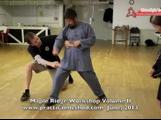- When you push correctly, your opponent feels that he is being pulled from behind him, this is the point you add a quick move to finish the push. There has to be a feeling on the part of your opponent that he is falling into “something”, being pulled into something. Otherwise, it is a push in it’s common sense, not in the taiji sense. For example, if you push a square box on pavement over a distance of ten feet, you are doing a common sense push. When you finish the push, the box is in a position similar to when you started, no better or worse. But if you push the box to the end of the pavement where there is a drainage hole, nudge it a bit, and it falls into the hole, then that is different. How can this be done? That’s the taiji way that cannot be described easily here.
- In regard to your rear kua and positive circle front push question, I can tell you that when the rear kua does not move forward and moves, instead, backward, and correctly, there will be a spiral force that comes out of this move, that is longer than the distance between the rear foot and the front hand. This is the taiji energy that we want to produce. This is only possible when there is a connection between the front hand and the rear foot with the manipulation of the kuas, elbows, knees, dantian, etc. In taiji, there is a saying, “when it is moving outwards, there is nothing outside of it; when it is moving inward, there is nothing inside it.” This quote means the outward energy movement is unlimitedly large; while the inward energy movement is unlimitedly small. Your rear kua questions touch upon this topic. Again no answers or explanations here yet.
- There is a concept called “demarcation”, without which there is no taiji separation. Roughly put, whenever you move, there is a point, only one, on your body that is neutral. Everything in front of it moves forward; everything behind it moves backward. People do not have this demarcation in the body without special training and therefore they won’t know the meaning. When this demarcation is present, there is the possibility of “connections” in energy movements in the body. This is again something very difficult to explain. It can be felt very easily and clearly. My online lessons only deal with clear and easy concepts (and yet they don’t appear to be clear to most people). The demarcation line is also what makes a push a pull.
Model Yilu
-
Video Trailers [+]
-
Books & Others [+]
Video Shop Catalog
Views
- Online Class Registration and Login - 89,605 views
- 30th Toronto Workshop Jan 24-27, 2026 - 552 views
- 2025 Chen Zhonghua Taiji Academy Activities Photos - 4,040 views
- Daqingshan Photos 2025 - 3,797 views
- Chen Zhonghua Student Portraits - 17,226 views
- Practical Method Web Dollars - 197,502 views
- Calendar - 110,446 views
- About Greater Vancouver - 106,808 views
- Contact - 88,544 views
- My Folder - 87,195 views
- Peng: Is it written 掤 or 棚? - 81,560 views
- Toronto Workshops and Classes - 56,098 views
- My Videos - 40,945 views
- Shop Catalog - 39,994 views
Copyright ©2005-2025 Hunyuan Taiji Academy. All Rights Reserved



{ 2 comments… read them below or add one }
Is there a relationship between the “demarcation line” and the “cliff” ?
When do we find in the form the “aim” and the stretching intent, similar to “expansion”?
Great job with the site for those who take the first steps in the real taiji!
“Demarcation line” and “cliff” are one of the same. Demarcation line is used theoretically. It is a point of reference. Cliff is when it is used in application such as push hands.
Expansion is physical. It involves aim and stretching.